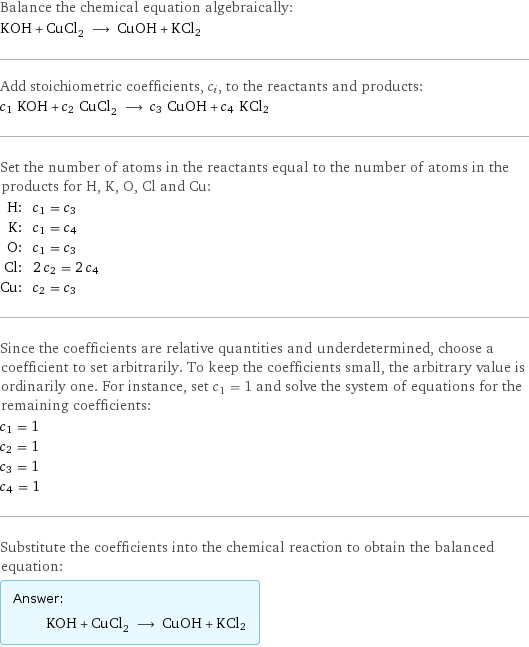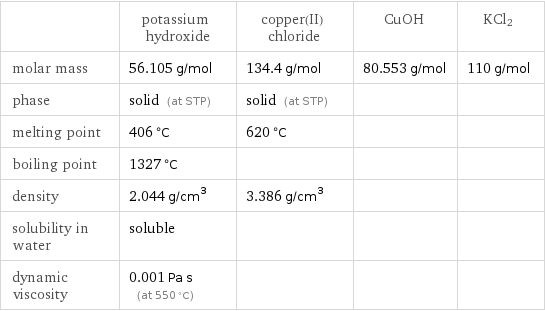Input interpretation

KOH potassium hydroxide + CuCl_2 copper(II) chloride ⟶ CuOH + KCl2
Balanced equation

Balance the chemical equation algebraically: KOH + CuCl_2 ⟶ CuOH + KCl2 Add stoichiometric coefficients, c_i, to the reactants and products: c_1 KOH + c_2 CuCl_2 ⟶ c_3 CuOH + c_4 KCl2 Set the number of atoms in the reactants equal to the number of atoms in the products for H, K, O, Cl and Cu: H: | c_1 = c_3 K: | c_1 = c_4 O: | c_1 = c_3 Cl: | 2 c_2 = 2 c_4 Cu: | c_2 = c_3 Since the coefficients are relative quantities and underdetermined, choose a coefficient to set arbitrarily. To keep the coefficients small, the arbitrary value is ordinarily one. For instance, set c_1 = 1 and solve the system of equations for the remaining coefficients: c_1 = 1 c_2 = 1 c_3 = 1 c_4 = 1 Substitute the coefficients into the chemical reaction to obtain the balanced equation: Answer: | | KOH + CuCl_2 ⟶ CuOH + KCl2
Structures

+ ⟶ CuOH + KCl2
Names

potassium hydroxide + copper(II) chloride ⟶ CuOH + KCl2
Equilibrium constant
![Construct the equilibrium constant, K, expression for: KOH + CuCl_2 ⟶ CuOH + KCl2 Plan: • Balance the chemical equation. • Determine the stoichiometric numbers. • Assemble the activity expression for each chemical species. • Use the activity expressions to build the equilibrium constant expression. Write the balanced chemical equation: KOH + CuCl_2 ⟶ CuOH + KCl2 Assign stoichiometric numbers, ν_i, using the stoichiometric coefficients, c_i, from the balanced chemical equation in the following manner: ν_i = -c_i for reactants and ν_i = c_i for products: chemical species | c_i | ν_i KOH | 1 | -1 CuCl_2 | 1 | -1 CuOH | 1 | 1 KCl2 | 1 | 1 Assemble the activity expressions accounting for the state of matter and ν_i: chemical species | c_i | ν_i | activity expression KOH | 1 | -1 | ([KOH])^(-1) CuCl_2 | 1 | -1 | ([CuCl2])^(-1) CuOH | 1 | 1 | [CuOH] KCl2 | 1 | 1 | [KCl2] The equilibrium constant symbol in the concentration basis is: K_c Mulitply the activity expressions to arrive at the K_c expression: Answer: | | K_c = ([KOH])^(-1) ([CuCl2])^(-1) [CuOH] [KCl2] = ([CuOH] [KCl2])/([KOH] [CuCl2])](../image_source/8956586522f5770425592a7b3c8da1ec.png)
Construct the equilibrium constant, K, expression for: KOH + CuCl_2 ⟶ CuOH + KCl2 Plan: • Balance the chemical equation. • Determine the stoichiometric numbers. • Assemble the activity expression for each chemical species. • Use the activity expressions to build the equilibrium constant expression. Write the balanced chemical equation: KOH + CuCl_2 ⟶ CuOH + KCl2 Assign stoichiometric numbers, ν_i, using the stoichiometric coefficients, c_i, from the balanced chemical equation in the following manner: ν_i = -c_i for reactants and ν_i = c_i for products: chemical species | c_i | ν_i KOH | 1 | -1 CuCl_2 | 1 | -1 CuOH | 1 | 1 KCl2 | 1 | 1 Assemble the activity expressions accounting for the state of matter and ν_i: chemical species | c_i | ν_i | activity expression KOH | 1 | -1 | ([KOH])^(-1) CuCl_2 | 1 | -1 | ([CuCl2])^(-1) CuOH | 1 | 1 | [CuOH] KCl2 | 1 | 1 | [KCl2] The equilibrium constant symbol in the concentration basis is: K_c Mulitply the activity expressions to arrive at the K_c expression: Answer: | | K_c = ([KOH])^(-1) ([CuCl2])^(-1) [CuOH] [KCl2] = ([CuOH] [KCl2])/([KOH] [CuCl2])
Rate of reaction
![Construct the rate of reaction expression for: KOH + CuCl_2 ⟶ CuOH + KCl2 Plan: • Balance the chemical equation. • Determine the stoichiometric numbers. • Assemble the rate term for each chemical species. • Write the rate of reaction expression. Write the balanced chemical equation: KOH + CuCl_2 ⟶ CuOH + KCl2 Assign stoichiometric numbers, ν_i, using the stoichiometric coefficients, c_i, from the balanced chemical equation in the following manner: ν_i = -c_i for reactants and ν_i = c_i for products: chemical species | c_i | ν_i KOH | 1 | -1 CuCl_2 | 1 | -1 CuOH | 1 | 1 KCl2 | 1 | 1 The rate term for each chemical species, B_i, is 1/ν_i(Δ[B_i])/(Δt) where [B_i] is the amount concentration and t is time: chemical species | c_i | ν_i | rate term KOH | 1 | -1 | -(Δ[KOH])/(Δt) CuCl_2 | 1 | -1 | -(Δ[CuCl2])/(Δt) CuOH | 1 | 1 | (Δ[CuOH])/(Δt) KCl2 | 1 | 1 | (Δ[KCl2])/(Δt) (for infinitesimal rate of change, replace Δ with d) Set the rate terms equal to each other to arrive at the rate expression: Answer: | | rate = -(Δ[KOH])/(Δt) = -(Δ[CuCl2])/(Δt) = (Δ[CuOH])/(Δt) = (Δ[KCl2])/(Δt) (assuming constant volume and no accumulation of intermediates or side products)](../image_source/6892fd7c84463791520ff4705d1fba5c.png)
Construct the rate of reaction expression for: KOH + CuCl_2 ⟶ CuOH + KCl2 Plan: • Balance the chemical equation. • Determine the stoichiometric numbers. • Assemble the rate term for each chemical species. • Write the rate of reaction expression. Write the balanced chemical equation: KOH + CuCl_2 ⟶ CuOH + KCl2 Assign stoichiometric numbers, ν_i, using the stoichiometric coefficients, c_i, from the balanced chemical equation in the following manner: ν_i = -c_i for reactants and ν_i = c_i for products: chemical species | c_i | ν_i KOH | 1 | -1 CuCl_2 | 1 | -1 CuOH | 1 | 1 KCl2 | 1 | 1 The rate term for each chemical species, B_i, is 1/ν_i(Δ[B_i])/(Δt) where [B_i] is the amount concentration and t is time: chemical species | c_i | ν_i | rate term KOH | 1 | -1 | -(Δ[KOH])/(Δt) CuCl_2 | 1 | -1 | -(Δ[CuCl2])/(Δt) CuOH | 1 | 1 | (Δ[CuOH])/(Δt) KCl2 | 1 | 1 | (Δ[KCl2])/(Δt) (for infinitesimal rate of change, replace Δ with d) Set the rate terms equal to each other to arrive at the rate expression: Answer: | | rate = -(Δ[KOH])/(Δt) = -(Δ[CuCl2])/(Δt) = (Δ[CuOH])/(Δt) = (Δ[KCl2])/(Δt) (assuming constant volume and no accumulation of intermediates or side products)
Chemical names and formulas

| potassium hydroxide | copper(II) chloride | CuOH | KCl2 formula | KOH | CuCl_2 | CuOH | KCl2 Hill formula | HKO | Cl_2Cu | HCuO | Cl2K name | potassium hydroxide | copper(II) chloride | | IUPAC name | potassium hydroxide | dichlorocopper | |
Substance properties

| potassium hydroxide | copper(II) chloride | CuOH | KCl2 molar mass | 56.105 g/mol | 134.4 g/mol | 80.553 g/mol | 110 g/mol phase | solid (at STP) | solid (at STP) | | melting point | 406 °C | 620 °C | | boiling point | 1327 °C | | | density | 2.044 g/cm^3 | 3.386 g/cm^3 | | solubility in water | soluble | | | dynamic viscosity | 0.001 Pa s (at 550 °C) | | |
Units
